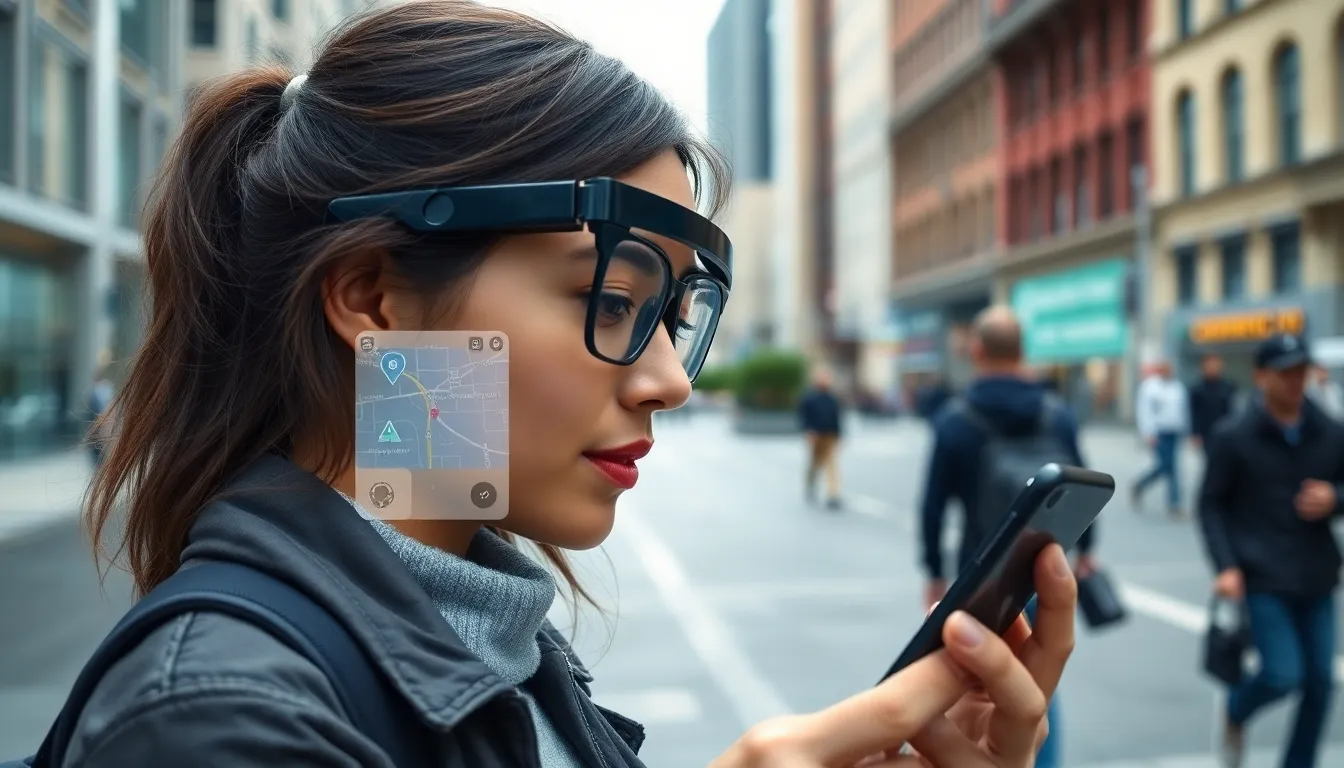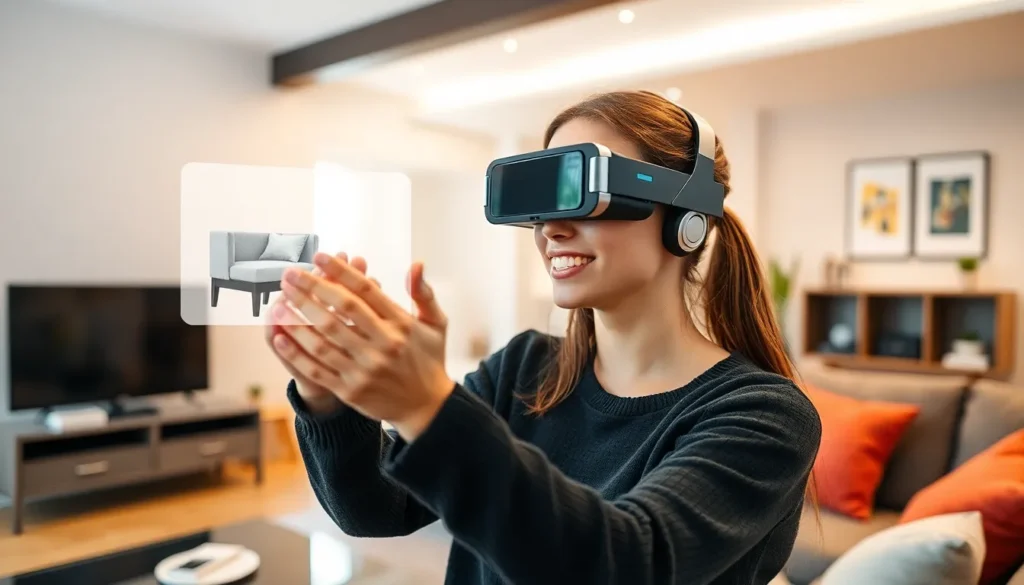In a world where reality sometimes feels a bit too mundane, augmented reality (AR) and virtual reality (VR) swoop in like superheroes, ready to spice things up. Imagine slipping on a headset and diving into a universe where you can battle dragons or stroll through ancient Rome—all without leaving your couch. Sounds tempting, right? But wait! AR has its own tricks up its sleeve, blending digital elements with the real world in ways that’ll make you question what’s real and what’s not.
Table of Contents
ToggleOverview of Augmented Reality vs Virtual Reality
Augmented reality (AR) overlays digital content onto the real world, enhancing everyday experiences. Users interact with virtual elements while remaining connected to their physical environment. For instance, smartphone apps can display 3D models of furniture in a user’s home setting.
Virtual reality (VR) immerses users in entirely digital environments, disconnecting them from the real world. Headsets transport individuals to captivating experiences, such as exploring fantastical landscapes or participating in simulations. This technology requires specialized equipment, reinforcing the sense of presence in a virtual realm.
Both AR and VR serve distinct purposes across various fields. AR finds applications in sectors like education and retail, providing interactive learning experiences or visualizing products before purchase. VR thrives in industries such as gaming and healthcare, offering training simulations and therapeutic environments.
Real-life examples demonstrate these technologies in action. Popular AR applications, such as Pokémon GO, blend gameplay with real-world locations. Noteworthy VR experiences, like Beat Saber, engage users in rhythm-based challenges within a fully immersive setting.
While both technologies share a foundation in digital enhancement, their methodologies differ significantly. AR enhances reality by integrating digital information, while VR creates a separate, immersive universe. Understanding these differences aids in identifying suitable applications for each technology.
Key Differences Between Augmented Reality and Virtual Reality

Augmented reality (AR) and virtual reality (VR) serve distinct functions within the realm of immersive technology. Understanding their definitions clarifies how they enhance experiences.
Definition of Augmented Reality
Augmented reality (AR) refers to technology that overlays digital information onto the real world. Users interact with both physical and digital elements simultaneously, creating an immersive experience that enhances reality. Advanced smartphones or AR glasses enable this interaction through visual displays. Applications of AR include navigation systems that show directions on a smartphone screen while driving. Popular examples like Pokémon GO allow users to interact with animated characters in real-world settings. This blend of digital and physical environments showcases AR’s utility across various sectors.
Definition of Virtual Reality
Virtual reality (VR) immerses users in fully digital environments, providing experiences that transport them away from their physical surroundings. Specialized equipment, such as headsets and motion controllers, is essential for this technology. Users can explore diverse worlds or participate in simulations that feel remarkably lifelike. Training programs in aviation or healthcare often utilize VR for realistic, hands-on experiences. Games like Beat Saber exemplify the engagement possible in VR, offering thrilling interactions within richly crafted spaces. By isolating users from reality, VR creates unique opportunities for learning and entertainment.
Applications of Augmented Reality
Augmented reality (AR) finds numerous applications across various industries and sectors. Its unique ability to blend digital content with the real world enhances user engagement and experience.
Industry Use Cases
Retail leverages AR for virtual try-ons, allowing customers to visualize products before purchasing. This technology transforms how shoppers interact with brands. Healthcare utilizes AR for surgical simulations, improving precision during complex operations. In education, AR enhances learning by providing interactive, 3D visualizations of complex concepts. Manufacturers also employ AR for maintenance and repair training, guiding technicians through detailed processes. Construction industries integrate AR to visualize architecture in real-world settings, reducing errors during planning and execution.
Entertainment and Gaming
AR revolutionizes gaming through immersive experiences that engage players in the real world. Popular games like Pokémon GO encourage exploration and physical activity, blending digital challenges with physical locations. AR applications foster interactive experiences at concerts and events, enriching audience participation. Beyond gaming, AR enables virtual storytelling, where users actively influence narratives. This technology also finds its way into social media, allowing users to apply fun filters and effects, enhancing their digital interactions. Engagement continues to grow as AR developers innovate with new features, elevating the entertainment landscape.
Applications of Virtual Reality
Virtual reality offers diverse applications across multiple fields. Significant advancements arise in training and simulation environments, enhancing both efficiency and engagement.
Training and Simulation
Training programs frequently incorporate virtual reality to create immersive learning experiences. Employees in industries such as aviation benefit from flight simulators that replicate real-world scenarios. Medical professionals utilize VR for practicing surgical techniques, enabling them to refine skills in a risk-free setting. Emergency responders train through realistic simulations, preparing them for high-stress situations without real consequences. Users often experience a heightened sense of presence, which improves knowledge retention rates by up to 75%.
Healthcare Innovations
Innovative healthcare uses of virtual reality transform patient treatments and training methods. Therapists apply VR to expose patients to phobias in controlled settings, enabling gradual desensitization. VR also supports pain management by distracting patients during medical procedures, resulting in reduced anxiety and discomfort. Medical students engage with 3D anatomical models, enhancing their understanding of complex bodily systems. Currently, research indicates that hospitals employing VR technologies witness improved patient outcomes and increased procedural accuracy.
Advantages and Disadvantages
The differences between augmented reality (AR) and virtual reality (VR) create unique advantages and disadvantages for each technology. Understanding these can help users choose the suitable option for their needs.
Pros and Cons of Augmented Reality
Augmented reality offers several benefits. It enhances reality by providing useful information without eliminating physical surroundings. Users can interact with digital elements like 3D models, leading to improved decision-making, particularly in retail. Accessibility factors heavily, as most smartphones already support AR applications. However, limitations exist. AR can struggle with complex environments, leading to inaccuracies if physical conditions change. Users may also experience distractions from the physical world, affecting immersion.
Pros and Cons of Virtual Reality
Virtual reality presents its own set of advantages. Immersion stands at the forefront, as VR transports users completely into digital environments, enhancing focus in training simulations. Various industries utilize VR for safe, realistic scenarios, bolstering training effectiveness, especially in healthcare and aviation. Despite its strengths, drawbacks appear. VR often requires expensive equipment like headsets, which can limit accessibility. Additionally, prolonged use may lead to discomfort, including motion sickness.
Future Trends in Augmented Reality and Virtual Reality
Continued advancements in AR and VR signify a transformative future. Manufacturers focus on refining hardware to enhance user experiences. For instance, companies are developing lighter and more comfortable headsets for VR to promote longer usage without discomfort. Aligning AR with wearable technology, brands are investing in smart glasses, increasing accessibility and functionality for everyday tasks.
Expanding applications in education reveal promising trends. Institutions are adopting AR to create immersive learning environments, boosting engagement and retention. Traditional subject matter becomes more interactive through AR visualizations. Meanwhile, VR provides realistic simulations for skill-based training, preparing students across various fields, like medicine and engineering.
Investment in AR and VR startups is increasing. Venture capitalists recognize the potential of these technologies in transforming industries like retail and healthcare. Innovative solutions, such as virtual fitting rooms or AR-enhanced surgical simulations, attract attention for their efficiency and effectiveness.
Collaboration between AR, VR, and artificial intelligence is gaining traction. Combining these technologies creates more personalized experiences. For example, AI can tailor virtual environments to individual user preferences, enhancing immersion and satisfaction.
User-generated content sees a rise thanks to AR and VR platforms. Individuals can create and share experiences, fostering community and creativity. This trend encourages diverse interactions, transforming how users perceive and engage with digital spaces.
Overall, emerging trends in augmented reality and virtual reality indicate significant growth potential. Enhanced user engagement and innovative applications across industries highlight the evolving landscape. As technology continues to advance, AR and VR will likely witness greater integration into daily life.
Augmented reality and virtual reality are reshaping how individuals interact with their environments and each other. Each technology offers unique experiences that cater to different needs and industries. AR enhances the physical world with digital overlays while keeping users grounded in reality. VR, on the other hand, transports users to entirely digital realms, creating immersive experiences that can be both entertaining and educational.
As these technologies continue to evolve, their applications are set to expand further. The integration of AR and VR into everyday life promises to revolutionize sectors like education, healthcare, and entertainment. With ongoing advancements and increased accessibility, the future looks bright for both augmented and virtual reality, paving the way for innovative experiences that blend the digital and physical worlds seamlessly.








